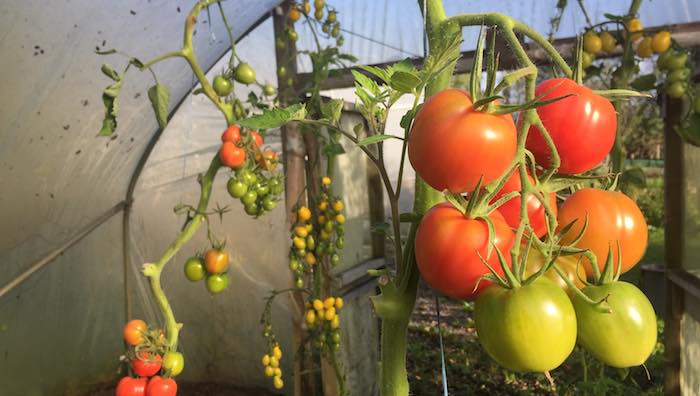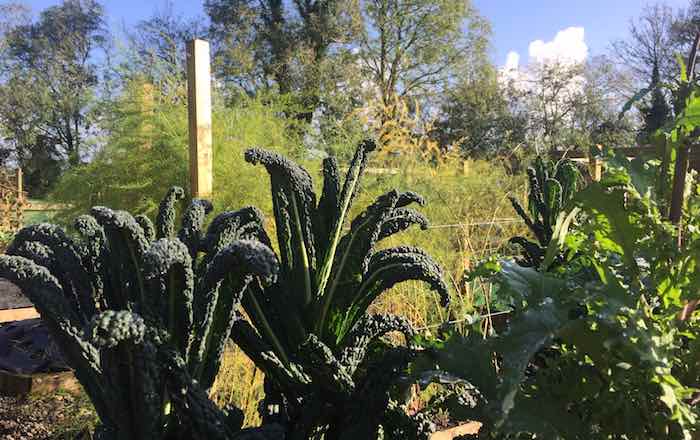An October Weekend in the Quickcrop Vegetable Garden
After a wet week last week, the weekend looked promising (well, Sunday at least) to get some work done in the garden and start preparing it for the Winter. As you may know, my garden is in an area of high rainfall which makes it very important for me to protect my soil and prevent nutrients being washed out.
Soluble nutrients like nitrogen are washed through the soil by heavy rain and end up below the root zone where they are not available to plants. Nitrogen can also leach into ground water and become a pollutant so either way it is best kept in the upper layers of the soil where it can be used.

You can see my reasonably tidy garden in the picture above with some raised beds in the foreground and my timber fruit cage behind. We often get questions on the site asking how long our raised beds last so I thought I should mention the ones in the photo are nearly 10 years old now and still going strong. If I were to dig them out I might see some signs of rot on the inside but so far they still look 100%
You can see I am using three of the beds for garlic and have covered them with our 'Gro-Grid' mats with pre-punched planting holes. The mats are designed for weed protection but they also have the advantage of protecting the soil from heavy rain.

Why does the soil need more protection in the winter? Soil needs more protection in the winter because, in most cases, you have harvested your crops so there is no natural cover to protect it. Plants provide shelter with their foliage but their roots are equally important as they mop up soluble nutrients which are then stored in the plant tissues. Roots are an integral part of the soil structure and support an even larger ecosystem in terms of numbers than the plant above ground.
Cover crops The best way to protect soil is in the way way nature intended, to grow something on it. Green manures like clover, phacelia or vetch are ideal for winter ground protection but need to be sown by September to build up enough plant and root mass to be beneficial. I must confess I have been very poor on this both in my own garden and in promoting cover crops in this newsletter. Unfortunately it is too late this season if you (or I) don't have them in but I will make sure to give plenty of warning next year.
I don't have any specific cover crops sown but I do have clumps of nasturtiums, nigella, and cornflower which I will leave in the beds for the soil protection they provide.

Feeding the soil As you are probably bored of hearing, I feed and protect my soil a this time of year by adding a layer of composted manure covered by seaweed. I am usually hoping for a decent storm around now which harvests some seaweed and throws it up on the beach for me to collect, luckily storm Lorenzo did the trick on Thursday night. You can see a neat dark line of fresh seaweed out the left of my windscreen and a further line at the high tide mark on the right hand side. The dark 'pile' straight ahead is Jess, our dog.
Please don't leave manure uncovered Seaweed is very beneficial in the garden and produces a wonderful soil improver when it rots down. My autumn additions will have almost disappeared by late spring but right now it makes a fantastic protective layer over any manure I add to the garden.

Remember that the although the nitrogen in manure is far less soluble than a man made fertilizer it will still be washed out over time. For the most part I use seaweed for this job but also cover manured beds with black plastic to keep the weather out. I'm not crazy about using a lot of plastic in the garden but given the nutrient loss (and potential need to add more in the spring), I figure the good outweighs the bad in this case.

October Harvests Before weeding and adding my soil amendments to the garden I cleared out the last of the root crops and put them into storage for the winter. You can see part of the haul above with some stubby carrots (I didn't get round to thinning them, no one's perfect), Mayan Gold potatoes (highly recommended) and some very nice beetroot (Pablo).
Root crops don't freeze well so unless you have a property with a cellar you'll have to make alternative arrangements. My compromise is a raised bed split into compartments and filled with a mix of compost and sand. The bed is placed in a cool shed and works pretty well. The compost and sand is kept slightly damp which prevents the vegetables loosing moisture and becoming spongy.

Tomaotes Earlier in the season I removed the lower leaves and the tops of my tomato plants to encourage any remaining fruit to ripen. Although it mightn't look like it in the photo we are nearly there, the yellow tomatoes are 'Yellow Pear' so are supposed to be like that, the ones in the foreground are 'Stupice' (I think). The once lush vines do look a bit miserable in their denuded state but stripping is very worthwhile unless you want a load of green tomatoes.

Overwintering salads You can also see some winter salads coming along nicely in one of the side beds, these will supply me with fresh leaves when there's not much else available in the garden. If you have a tunnel and have installed a timed irrigation system remember to reduce the watering sessions as light and temperature decreases. You want just the bare minimum of watering for winter crops, also open the tunnel on bright days to let some air through and reduce the chance of fungal disease.

Winter heavyweights The last photo is two of the winter heavyweights which I couldn't do without, Cavalo nero kale and Russian kale (to the right). These hardy plants will shrug of any weather while providing highly nutritious greens throughout the winter. We have been picking from these plants all summer already so they are very nearly a 12 month crop, they even give a treat next spring when they go to seed as their immature flower heads are just as good as sprouting broccoli.

Winter Salads With weather and light quality changing many gardeners are now moving indoors to extend the salad season under glass and cultivate some microgreens. Microgreens are tender, young green vegetables, packed with essential nutrients, harvested at the first or second leaf stage and used as a culinary ingredient. They are extremely easy to grow and are becoming increasingly popular with restaurants.
Technically most plants can be grown as microgreens but the favoured options are from the brassica family. These include cress, a favourite in cucumber or egg sandwiches, mustard, daikon radish, broccoli, cabbage, and any of the oriental salads like pak choi and tatsoi. Basil, dill, beetroot, peas, coriander, rocket and mizuna can all be grown for their tender foliage.

Vitopod Large Propagator with Lights & Support Brackets
View ProductA light source should be provided to prevent the seedlings becoming spindly and developing fungal diseases or leggyness. The Vitopod or the Growlight system are ideal for this and can be height adjusted as the plants grow and develop.
Propagation Propagators are a vital tool for Winter gardening and can be brought out to cover a number of tasks. Overwintering plants will appreciate the protection given under glass as will semi-ripe cuttings which should be taken around mid-Autumn. We take many cuttings at this time of year, it’s the perfect way to build up stock and to replace ageing or diseased plants. Herbs, shrubs, groundcover and hedging can all be replenished quite easily.

Cuttings are taken from this year’s growth, usually about 10-15cm long, and propagated in moist compost mixed with sand or grit to aid drainage. Snip with sharp, clean secateurs to avoid any disease and remove the lower leaves from the slip. Use hormonal rooting powder if you wish. The warm, humid environment of a propagator is a welcome refuge and will promote early root development, giving the young plants a head start for next Spring. Remember to harden them off before planting out next year.
That's about it for today. Next week we will be looking at Autumn planted fruit and planning and building a fruit garden.
Andrew

